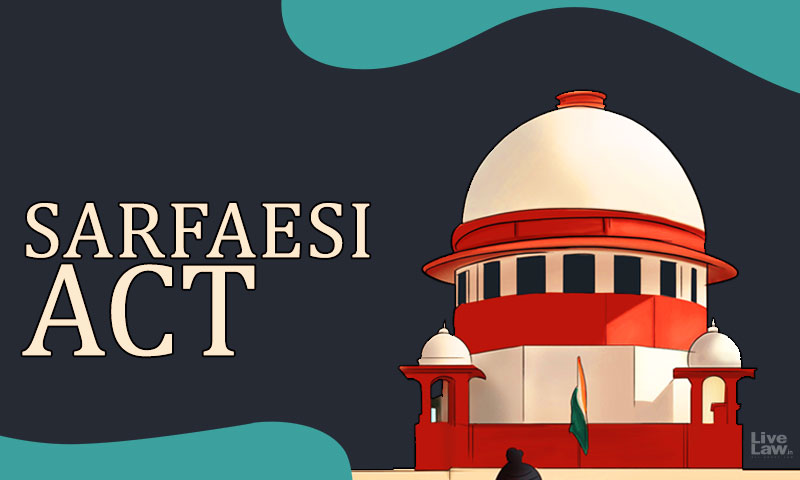The Supreme Courtroom held that the District Justice of the Peace, Chief Metropolitan Justice of the Peace is just not a persona designata for the needs of Part 14 of the SARFAESI Act.
Thus, the expression “District Justice of the Peace” and the “Chief Metropolitan Justice of the Peace” as showing in Part 14 of the SARFAESI Act shall deem to imply and embody Extra District Justice of the Peace and Extra Chief Metropolitan Justice of the Peace for the needs of Part 14 of the SARFAESI Act, the bench comprising Justices MR Shah and BV Nagarathna noticed whereas upholding the Bombay Excessive Courtroom judgment.
The court docket due to this fact overruled the opposite view taken in some judgments of the Excessive Courts of Gujarat, Calcutta and Kerala.
The bench was dismissing an attraction in opposition to the Bombay Excessive Courtroom judgment which noticed that the Extra Chief Metropolitan Justice of the Peace ( “ACMM”), being invested with all of the judicial powers of the Chief Metropolitan Justice of the Peace, may be thought of at par with the Chief Metropolitan Justice of the Peace.
In attraction earlier than the Apex Courtroom, Advocate Purvish Jitendra Malkan relied on Hari Chand Aggarwal Vs. Batala Engineering Co. Ltd. and Ors.; (1969) 2 SCR 201 to contend that District Justice of the Peace and Extra District Justice of the Peace are the distinct authorities and the Extra District Justice of the Peace is subordinate to the District Justice of the Peace and due to this fact, the Extra District Justice of the Peace being subordinate can not train the powers of the District Justice of the Peace. The counsel additionally relied on the judgment of (1) Gujarat Excessive Courtroom in Pushpa Devi B Jain W/o Bhawarlal M Jain Vs. Indian Abroad Financial institution in Particular Civil Software No. 19102/2015 (2) Calcutta Excessive Courtroom within the case of Shri Chellaperumal & Anr. Vs. The Authorised Officer & Ors. in M.A. No. 26/2014 and (3) Kerala Excessive Courtroom within the case of Aseena Vs. SubDivisional Justice of the Peace.
The State, by Advocate Sachin Patel, supported the impugned judgment contending that trying to the mandate underneath Part 14 of the SARFAESI Act to resolve and eliminate the purposes underneath Part 14 inside a most interval of 60 days and trying to the quantity of 11 the work and purposes pending with the District Magistrates or the Chief Metropolitan Magistrates and that they’ve additionally to take care of and think about different duties together with the executive work and with a view to see that the final word object and function of offering the time strains in deciding the purposes underneath Part 14 of the SARFAESI Act.
Thus the problem raised on this attraction was:
(1) Whether or not the Extra District Justice of the Peace or Extra Chief Metropolitan Justice of the Peace might train the powers underneath Part 14 of the SARFAESI Act
(2) whether or not the expression “District Justice of the Peace” and the “Chief Metropolitan Justice of the Peace” as showing in Part 14 of the SARFAESI Act shall deem to imply and embody Extra District Justice of the Peace and Extra Chief Metropolitan Justice of the Peace for the needs of Part 14 of the SARFAESI Act, the powers exercisable by the District Justice of the Peace (for brief “DM”) and the Chief Metropolitan Justice of the Peace (for brief “CMM”) underneath Part 14 of the SARFAESI Act?
Part 14 powers exercised by the CMM/DM is a ministerial act
The bench first observed that the Part 14 doesn’t contain an adjudicatory course of qua factors raised by the borrower in opposition to the secured creditor taking possession of secured property
Nevertheless, for taking bodily possession of the secured property by way of Part 14(1) of the SARFAESI Act, the secured creditor is obliged to strategy the CMM/DM by the use of a written software requesting for taking possession of the secured property and paperwork relating thereto and for being forwarded to it (secured creditor) for additional motion. The statutory obligation enjoined upon the CMM/DM is to instantly transfer into motion after receipt of a written software underneath Part 14(1) of the SARFAESI Act from the secured creditor for that function. As quickly as such an software is acquired, the CMM/DM is predicted to cross an 19 order after verification of compliance of all formalities by the secured creditor referred to within the proviso in Part 14(1) of the SARFAESI Act and after being glad in that regard, to take possession of the secured property and paperwork relating thereto and to ahead the identical to the secured creditor on the earliest alternative. As mandated by Part 14 of the SARFAESI Act, the CMM/DM has to behave inside the stipulated time restrict and cross an acceptable order for the aim of taking possession of the secured property inside a interval of 30 days from the date of software which may be prolonged for such additional interval however not exceeding within the combination, sixty days. Thus, the powers exercised by the CMM/DM is a ministerial act. He can not brook delay. Time is of the essence. That is the spirit of the particular enactment.
Comments
0 comments
